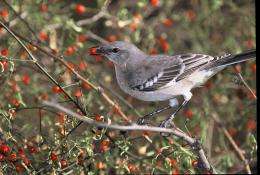Scientists Develop New Method for Tracking Seed Dispersal and Establishment

(PhysOrg.com) -- A Penn State biologist and his collaborators have developed a new method for tracking seed movement and germination. According to Tomás Carlo, assistant professor of biology at Penn State and the leader of the study, the technique will be useful for studying plant dispersal and how plants adjust to global climate change. The technique also will enable scientists to gather biological information about invasive plants that is critical to controlling their spread. The team's results appeared in the December 2009 issue of the journal Ecology.
"Organisms will have to migrate to cope with climate change," said Carlo. "So there is interest among scientists in estimating patterns of seed dispersal, especially in the fragmented and highly altered landscapes that humans have created. Our technique could help scientists to understand the likelihood that a particular plant species will be successful at shifting its range in response to climate change. The technique also could help land managers to control invasive species. By understanding how invasive species spread, we can attempt to prevent them from getting to places where they are predicted to go."
The team's new approach is based on an isotope tracer method that for many years has been used in the laboratory and the field to investigate metabolic pathways in cells and to track movement of fluids through soils. However, no one, until now, had used such a method to study seed dispersal and seedling establishment.
Carlo and his team applied solutions of nitrogen-15, a stable, heavy isotope of nitrogen, to the leaves of plants. The plants soaked up the enriched solution and incorporated the nitrogen-15 into their tissues, including the seeds that they later would produce. The seedlings that grew from these seeds even maintained very high signatures of nitrogen-15, thousands of times higher than natural levels. "Nitrogen-15 is naturally very rare, so when you detect an enriched nitrogen-15 signature in a seed or seedling, you know that it comes from one of your labeled parent plants," said Carlo, who added that the application of nitrogen-15 to plants is in no known way harmful to the environment and that the isotopic signature fades from the treated plants and their offpsring as they grow.
According to Carlo, traditional methods for studying seed dispersal and establishment have relied on expensive and lab-intensive genetic techniques. "To study dispersal using genetics, you have to work backward," he said. "First, you must determine the genotype, or genetic makeup, of the seed or seedling, and then you must determine the genotypes of nearby individual plants until you find the parents. This can be expensive and time-consuming, especially considering that many plants disperse long distances as a result of animals eating the fruits and depositing them hundreds of meters away from the parent plant," said Carlo. "An advantage of this technique is that it allows seeds to be processed in large numbers quickly, and that hundreds of seeds can be combined into a single "batch" and analyzed with the aid of mixing-models, which saves time and money."
Carlo tested his new approach in the field with several species of plants and trees, but he conducted his most thorough tests by spraying wild chili-pepper plants in southern Arizona with a nitrogen-15 solution in the form of urea. Later, after the plant's seeds had been dispersed by birds, he collected the seeds and seedlings, ground them up, and placed a tiny sub-sample into a laboratory device, called a mass spectrometer, to measure the amount of nitrogen-15. "We found that all of the seeds and seedlings that came from the plant that we had treated had strong nitrogen-15 signatures."
The team also found that they could track seed dispersal for up to three individuals at a time by spraying parent plants with different concentrations of urea. The levels of nitrogen-15 detected in the seeds and seedlings reflected the original treatment concentrations. In addition, the team was able to estimate the number of seeds in their samples that had come from treated plants versus untreated plants.
"Measuring seed dispersal is daunting because the farther away you move from a place the less likely it is that you'll find seeds from your source and the more likely it is that you'll find seeds from other sources of that species," said Carlo. "The beauty of this method is that it allows us to estimate the number of seeds from a mixed batch of treated and untreated seeds."
One problem Carlo foresees with the technique is the possibility that separate studies could overlap and interfere with each other. "If another scientist was using the same technique on the same species in the same geographic area, it could compromise my results," said Carlo. "A Web site in which scientists can inform others that they are planning to conduct an experiment could be a good way to get around this problem."
More information: www.esajournals.org/loi/ecol
Provided by Pennsylvania State University

















